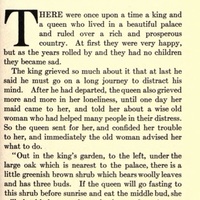Grundtvig, Svendt. “The Princess in the Coffin.” Danish Fairy Tales, translated by J. Grant Cramer, Boston: The Four Seas Company, 1919, pp. 45-58.
Item
Title
Grundtvig, Svendt. “The Princess in the Coffin.” Danish Fairy Tales, translated by J. Grant Cramer, Boston: The Four Seas Company, 1919, pp. 45-58.
Description
In this thrilling rendition of a princess in a coffin, you witness a royal couple’s unusual quest for parenthood. A wicked prophecy is cast upon an unnaturally born princess, and the King’s lack of patience and brings about a great misfortune. The princess is revived but at a great cost to a great number of men who lose their lives. This version of the tale is not written for young readers, as it presents great horrors and a lack of illustrations and so a child reader would probably not be greatly entertained. Although the editor of the volume was a Danish folklorist, the American translator claims to have heard the same stories when he lived in Denmark as a child. It follows a similar plot path to many other Princess in a Chest Fairy tales, including Straparola’s early version (1550), the tale of Tebaldo and Doralice. But this version contains many Christian references, including a protagonist called Christian who prays to God and setting in a Church.
Alternative Title
Danish Fairy Tales
Creator
Svendt Grundtvig , translated by J. Grant Cramer
Svendt Grundtvig
Spatial Coverage
Boston
Coverage
United States
Publisher
The Four Seas Company
Date
1919
Temporal Coverage
1910-1919
Identifier
Persecuted Maidens
Abstract
In this Danish rendition of the Princess in a Coffin tale type, you observe a king and queen that are unable to naturally bear a child, so they must seek the help of a wise old woman to fulfill their desires. The queen becomes pregnant after she fulfills the prophecy and gives birth to a beautiful, perfect princess whose intellect is that of a grown wise man upon her birth. The child, however, is cursed and must not be seen by either parent until after her 14th birthday or else there will be great misfortune brought upon their kingdom. The king cannot wait for such a lengthy amount of time to see his daughter, so on the day before her 14th birthday, he breaks into the room and the princess says he must pick one of three misfortunes. The king picks the lesser evil, and the following day the princess dies and is put into a wooden coffin. Upon her death, the princess insists that her coffin must be guarded by a guard every night until she awakes again, but every guard that is sent to guard the coffin mysteriously disappears and is never found again. Then a man comes along who against all odds agrees to guard the coffin once more. When the next dawn breaks, the people find him alive and well. He then demands an extraordinary amount of pay to proceed to guard the coffin for the next two days. Every night he attempts to escape, but a dwarf forcefully brings him back and gives him advice on how to remain alive. He then discovers that the princess’s ghost exits the coffin every night in an attempt to slay the guard. On the third night, the princess and the guard of the coffin are both alive and well on the next morning, and they get married and live happily ever after.
Source
Straparola’s tale of Tebaldo and Doralice (Night 1, Tale 4)
This item was submitted on April 17, 2020 by [anonymous user] using the form “Submit a Fairy Tale” on the site “Fairy Tales Repository”: https://fairytales.suzannemagnanini.buffscreate.net/s/ft
Click here to view the collected data.
